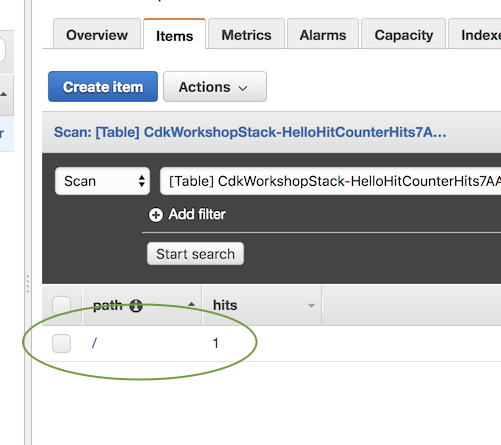Allow Lambda to read/write our DynamoDB table #
Let’s give our Lambda’s execution role permissions to read/write from our table.
Go back to ~/HitCounter.java and add the following highlighted lines:
package com.myorg;
import java.util.HashMap;
import java.util.Map;
import software.constructs.Construct;
import software.amazon.awscdk.services.dynamodb.Attribute;
import software.amazon.awscdk.services.dynamodb.AttributeType;
import software.amazon.awscdk.services.dynamodb.Table;
import software.amazon.awscdk.services.lambda.Code;
import software.amazon.awscdk.services.lambda.Function;
import software.amazon.awscdk.services.lambda.Runtime;
public class HitCounter extends Construct {
private final Function handler;
private final Table table;
public HitCounter(final Construct scope, final String id, final HitCounterProps props) {
super(scope, id);
this.table = Table.Builder.create(this, "Hits")
.partitionKey(Attribute.builder()
.name("path")
.type(AttributeType.STRING)
.build())
.build();
final Map<String, String> environment = new HashMap<>();
environment.put("DOWNSTREAM_FUNCTION_NAME", props.getDownstream().getFunctionName());
environment.put("HITS_TABLE_NAME", this.table.getTableName());
this.handler = Function.Builder.create(this, "HitCounterHandler")
.runtime(Runtime.NODEJS_14_X)
.handler("hitcounter.handler")
.code(Code.fromAsset("lambda"))
.environment(environment)
.build();
// Grants the lambda function read/write permissions to our table
this.table.grantReadWriteData(this.handler);
}
/**
* @return the counter definition
*/
public Function getHandler() {
return this.handler;
}
/**
* @return the counter table
*/
public Table getTable() {
return this.table;
}
}Deploy #
Save & deploy:
mvn package
cdk deploy
Test again #
Okay, deployment is complete. Let’s run our test again (either use curl or
your web browser):
curl -i https://xxxxxxxxxx.execute-api.us-east-1.amazonaws.com/prod/
Again?
HTTP/1.1 502 Bad Gateway
...
{"message": "Internal server error"}
😢 #
Still getting this pesky 5xx error! Let’s look at our CloudWatch logs again (click “Refresh”):
{
"errorType": "AccessDeniedException",
"errorMessage": "User: arn:aws:sts::XXXXXXXXXX:assumed-role/CdkWorkshopStack-HelloHitCounterHitCounterHandlerS-TU5M09L1UBID/CdkWorkshopStack-HelloHitCounterHitCounterHandlerD-144HVUNEWRWEO is not authorized to perform: lambda:InvokeFunction on resource: arn:aws:lambda:us-east-1:XXXXXXXXXXX:function:CdkWorkshopStack-HelloHandler2E4FBA4D-149MVAO4969O7",
"stack": [
"AccessDeniedException: User: arn:aws:sts::XXXXXXXXXX:assumed-role/CdkWorkshopStack-HelloHitCounterHitCounterHandlerS-TU5M09L1UBID/CdkWorkshopStack-HelloHitCounterHitCounterHandlerD-144HVUNEWRWEO is not authorized to perform: lambda:InvokeFunction on resource: arn:aws:lambda:us-east-1:XXXXXXXXXXX:function:CdkWorkshopStack-HelloHandler2E4FBA4D-149MVAO4969O7",
"at Object.extractError (/var/runtime/node_modules/aws-sdk/lib/protocol/json.js:48:27)",
"at Request.extractError (/var/runtime/node_modules/aws-sdk/lib/protocol/rest_json.js:52:8)",
"at Request.callListeners (/var/runtime/node_modules/aws-sdk/lib/sequential_executor.js:105:20)",
"at Request.emit (/var/runtime/node_modules/aws-sdk/lib/sequential_executor.js:77:10)",
"at Request.emit (/var/runtime/node_modules/aws-sdk/lib/request.js:683:14)",
"at Request.transition (/var/runtime/node_modules/aws-sdk/lib/request.js:22:10)",
"at AcceptorStateMachine.runTo (/var/runtime/node_modules/aws-sdk/lib/state_machine.js:14:12)",
"at /var/runtime/node_modules/aws-sdk/lib/state_machine.js:26:10",
"at Request.<anonymous> (/var/runtime/node_modules/aws-sdk/lib/request.js:38:9)",
"at Request.<anonymous> (/var/runtime/node_modules/aws-sdk/lib/request.js:685:12)"
]
}
Another access denied, but this time, if you take a close look:
User: <VERY-LONG-STRING> is not authorized to perform: lambda:InvokeFunction on resource: <VERY-LONG-STRING>"
So it seems like our hit counter actually managed to write to the database. We can confirm by going to the DynamoDB Console:

But, we must also give our hit counter permissions to invoke the downstream lambda function.
Grant invoke permissions #
Add the highlighted lines to src/CdkWorkshop/HitCounter.java:
package com.myorg;
import java.util.HashMap;
import java.util.Map;
import software.constructs.Construct;
import software.amazon.awscdk.services.dynamodb.Attribute;
import software.amazon.awscdk.services.dynamodb.AttributeType;
import software.amazon.awscdk.services.dynamodb.Table;
import software.amazon.awscdk.services.lambda.Code;
import software.amazon.awscdk.services.lambda.Function;
import software.amazon.awscdk.services.lambda.Runtime;
public class HitCounter extends Construct {
private final Function handler;
private final Table table;
public HitCounter(final Construct scope, final String id, final HitCounterProps props) {
super(scope, id);
this.table = Table.Builder.create(this, "Hits")
.partitionKey(Attribute.builder()
.name("path")
.type(AttributeType.STRING)
.build())
.build();
final Map<String, String> environment = new HashMap<>();
environment.put("DOWNSTREAM_FUNCTION_NAME", props.getDownstream().getFunctionName());
environment.put("HITS_TABLE_NAME", this.table.getTableName());
this.handler = Function.Builder.create(this, "HitCounterHandler")
.runtime(Runtime.NODEJS_14_X)
.handler("hitcounter.handler")
.code(Code.fromAsset("lambda"))
.environment(environment)
.build();
// Grants the lambda function read/write permissions to our table
this.table.grantReadWriteData(this.handler);
// Grants the lambda function invoke permissions to the downstream function
props.getDownstream().grantInvoke(this.handler);
}
/**
* @return the counter definition
*/
public Function getHandler() {
return this.handler;
}
/**
* @return the counter table
*/
public Table getTable() {
return this.table;
}
}Diff #
You can check what this did using cdk diff:
mvn package
cdk diff
The Resource section should look something like this, which shows the IAM statement was added to the role:
IAM Statement Changes
┌───┬────────────────────────────────────────┬────────┬────────────────────────────────────────┬─────────────────────────────────────────┬───────────┐
│ │ Resource │ Effect │ Action │ Principal │ Condition │
├───┼────────────────────────────────────────┼────────┼────────────────────────────────────────┼─────────────────────────────────────────┼───────────┤
│ + │ ${HelloHandler.Arn} │ Allow │ lambda:InvokeFunction │ AWS:${HelloHitCounter/HitCounterHandler │ │
│ │ │ │ │ /ServiceRole} │ │
├───┼────────────────────────────────────────┼────────┼────────────────────────────────────────┼─────────────────────────────────────────┼───────────┤
│ + │ ${HelloHitCounter/Hits.Arn} │ Allow │ dynamodb:BatchGetItem │ AWS:${HelloHitCounter/HitCounterHandler │ │
│ │ │ │ dynamodb:BatchWriteItem │ /ServiceRole} │ │
│ │ │ │ dynamodb:DeleteItem │ │ │
│ │ │ │ dynamodb:GetItem │ │ │
│ │ │ │ dynamodb:GetRecords │ │ │
│ │ │ │ dynamodb:GetShardIterator │ │ │
│ │ │ │ dynamodb:PutItem │ │ │
│ │ │ │ dynamodb:Query │ │ │
│ │ │ │ dynamodb:Scan │ │ │
│ │ │ │ dynamodb:UpdateItem │ │ │
└───┴────────────────────────────────────────┴────────┴────────────────────────────────────────┴─────────────────────────────────────────┴───────────┘
(NOTE: There may be security-related changes not in this list. See https://github.com/aws/aws-cdk/issues/1299)
Resources
[+] AWS::IAM::Policy HelloHitCounter/HitCounterHandler/ServiceRole/DefaultPolicy HelloHitCounterHitCounterHandlerServiceRoleDefaultPolicy1487A60A
[~] AWS::Lambda::Function HelloHitCounter/HitCounterHandler HelloHitCounterHitCounterHandlerDAEA7B37
└─ [~] DependsOn
└─ @@ -1,3 +1,4 @@
[ ] [
[+] "HelloHitCounterHitCounterHandlerServiceRoleDefaultPolicy1487A60A",
[ ] "HelloHitCounterHitCounterHandlerServiceRoleD45002B8"
[ ] ]
Which is exactly what we wanted.
Deploy #
Okay… let’s give this another shot:
cdk deploy
Then hit your endpoint with curl or with your web browser:
curl -i https://xxxxxxxxxx.execute-api.us-east-1.amazonaws.com/prod/
Output should look like this:
HTTP/1.1 200 OK
...
Hello, CDK! You've hit /
If you still get 5xx, give it a few seconds and try again. Sometimes API Gateway takes a little bit to “flip” the endpoint to use the new deployment.